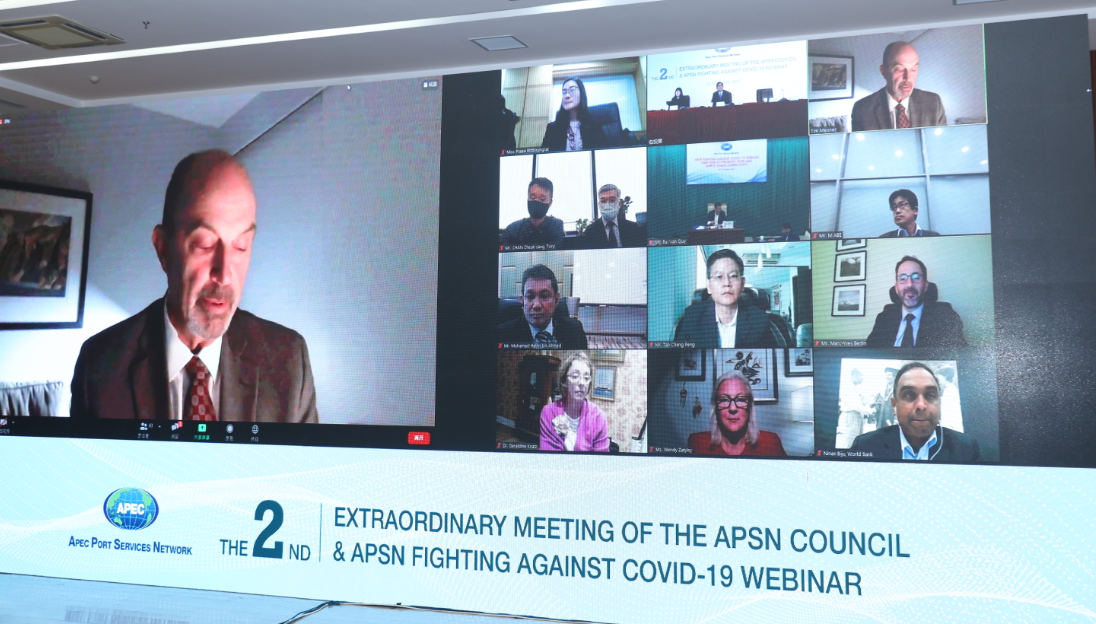
The APSN Fighting Against COVID-19 Webinar was held successfully on October 20, 2020. The theme of the Webinar is “Keep Open to Promote Port and Supply Chain Connectivity”. Mr. Tim Meisner, Senior Consultant of the APSN, moderated the Webinar.
Mr. Marc-Yves Bertin, President of the APSN Council, welcomed all speakers and participants to the APSN Webinar. Delegates from 15 APEC Member Economies attended the Webinar, including Canada; China; Hong Kong, China; Indonesia; Japan; Republic of Korea; Malaysia; Papua New Guinea; Peru; the Philippines; Russia; Singapore; Thailand; the United States and Viet Nam. Senior representatives from such international organizations as the World Bank, the International Maritime Organization and the United Nations Economic and Social Commission for Asia and the Pacific were also present at the Webinar.
Atotal number of ten speakers provided high quality presentations and discussions on the impact of COVID-19 pandemic on the global economy and the port industry, epidemic responses of the APEC port and shipping industries, and the challenges faced by the port and related industries, which are of common concern to all economies. Speakers include senior officials from port authorities, industry leaders, experts from research institutes and senior representatives from international organizations.
COVID-19 Impacts on the APEC Port Industry
Because of the restrictions on cross-border personnel flow and contact control, consumption and demand in certain sectors slowing down, supply chain localization and reindustrialization, the global economy has significantly declined. The global economy, including the economy of many APEC Member Economies, has also experienced a sharp decline in the beginning of 2020 due to the huge economic and social impact brought by the pandemic. Cargo throughput has also fallen, which impacted the income of employees in port and related industries. Cruise industries of almost all APEC Member Economies have almost been shut down. The difficulty of crew change of international seafarers has become a prominent issue and a global concern.
As maritime transport serves as an important support for economic development and people’s livelihood, the world has been striving to restore and stabilize maritime freight transport. The port freight and production in Member Economies such as Canada and China, has started to rebound since the second quarter of 2020. In terms of cargo type, container and bulk cargo has rebounded in the first place. In the post-COVID “new normal” era, the demand of keeping the normal and stable operation of the port and logistics supply chain has accelerated the digital transformation and development in relevant industries.
COVID-19 Responses
All APEC Member Economies have adopted various pandemic prevention and monitoring measures such as wearing masks, monitoring body temperature, and controlling access in/out of ports, working from home, and positive cases quarantine etc., in order to ensure the operation of ports and to guarantee the health of its workers. China, Malaysia, Thailand and other economies have issued a number of regulations and guidelines on prevention and control of COVID-19. Meanwhile, China, Singapore, and Thailand have issued a series of fiscal policies such as tax reduction, port fee reduction and financial support to keep severely impacted port and shipping logistics industry operating and to promote the recovery of production in relevant industries. Economies such as Canada and Thailand have provided humanitarian aid to the vulnerable port communities by voluntary work.
While the pandemic has accelerated the digitization of the whole industry, various economies and international organizations have reached a broad consensus on actively promoting and deepening the digital transformation and development of the port and logistics supply chain, and put forward a number of measures and initiatives. Canadian ports have started to apply artificial intelligence technology to assist medical cargo transportation. China has carried out a large number of technology development and application measures on digital logistics information, port operation intelligence and pandemic prevention intelligence. Singapore has proposed to build a digital port through standardized global data connectivity and data sharing. The United States has accelerated the application of automated and unmanned technique in port logistics industry. The APEC TPT-WG has continued to track the impact of digitization on the port logistics industry, and carried out relevant practice analysis and capacity-building initiatives for its members. The World Bank Group has provided financial support for digitization projects in port and logistics industry to many economies. It also calls for all sectors to work together in building transparent, neutral and open data and information platform on ship arrival, port community system, single-window to accelerate port digitalization.
In order to deal with the difficulties of crew change, China; Hong Kong China; Singapore; Thailand and other economies have opened ports to foreign seafarers to change crew. Malaysia has opened ports to domestic crew through standard procedures. Canada has provided various care and convenience for crew on international call-on ships.
The above-mentioned problems cannot be solved by a single port alone. The APEC Member Economies and international organizations have expressed that multi-level coordination and cooperation involving all stakeholders, including international, domestic, different government departments, governments and enterprises, should be developed and deepened to respond to the pandemic and promote the development of the port industry. Several speakers highlighted the important role of government agencies in various economies and international organizations such as IMO in coordinating and promoting relevant cooperation.
Future Challenges
Since COVID-19 pandemic is still overshadowing the global economy, the port industry and the global cruise industry in severely impacted economies are still facing serious challenges, such as recession and shut-down.
The new normal in post-COVID era has bought up issues of management and operation in port and related industries, which include the difficulty of transport and business model transition, rising costs in prevention and control of COVID-19, psychological problems by home isolation and etc.
In the context of the accelerated digitalization in port and logistics supply chain, ports in developing economies are facing a gap between poor infrastructure and advanced technology.

